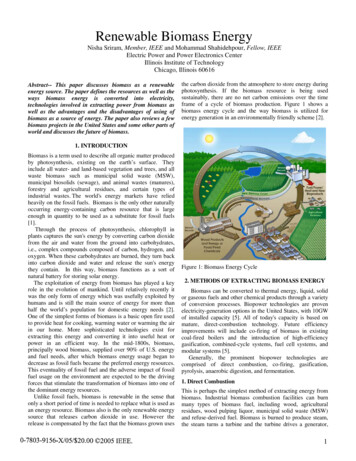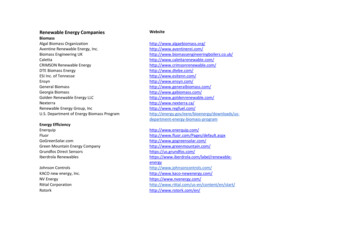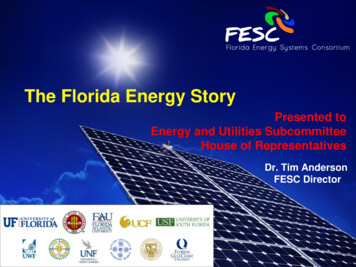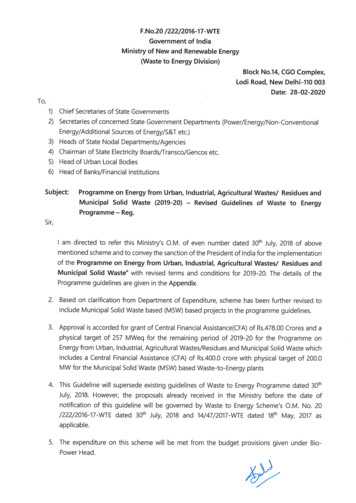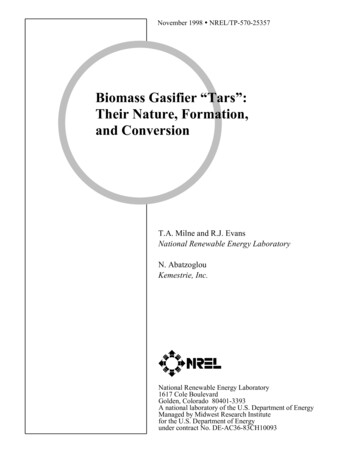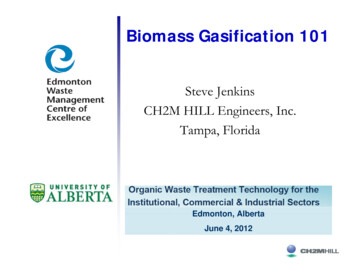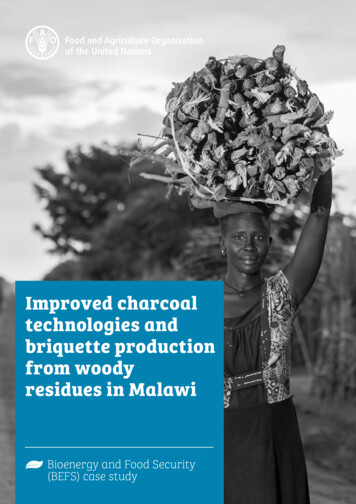
Transcription
Handbook of BiomassDowndraft GasifierEngine SystemsSERIISP-271-3022DE88001135March 1988UC Category.' 245This handbook has been prepared by the Solar Energy Research Institute under the U.S.Department of Energy Solar Technical Information Program. It is intended as a guideto the design, testing, operation, and manufacture of small-scale [less than 200 kW(270 hpJ] gasifiers. A great deal of the information will be useful for all levels of biomassgasification.The handbook is meant to be a practical guide to gasifier systems, and a minimumamount of space is devoted to questions of more theoretical interest.We apologize in advance for mixing English and Scientifique Internationale (SI) units.Whenever possible, we have used SI units, with the corresponding English units fol lowing in parentheses. Unfortunately, many of the figures use English units, and itwould have been too difficult to convert all of these figures to both units. We have sup plied a conversion chart in the Appendix to make these conversions easier for thereader.Mr. Bill Nostrand, one of our very helpful reviewers, died in May 1985. Bill was num ber one in the ranks of those who became interested in gasification because of its poten tial for supplying clean, renewable energy. We all will miss him. The improvement ofgasification systems will be noticeably slowed by his death.We dedicate this book to the Bill Nostrands of this world who will bring gasifier systemsto the level of safety, cleanliness, and reliability required to realize their full potential.Thanks, Bill.T B. Reed and A. DasGolden, ColoradoA Product of theSolar Technical Information ProgramSolar Energy Research Institute1 617 Cole Boulevard, Golden, Colorado 80401-3393A Division of Midwest Resea rch InstituteU.S. Department of EnergyOperated for the
AcknowledgmentsSince it is impossible for one or two authors to realistically comprehend a subject from all viewpoints, we havesolicited input from leading workers in the field. Early versions were sent to a number of investigators, and eachwas invited to comment on and supplement our effort. We therefore express our heartfelt thanks to the followingreviewers for greatly enhancing the quality of the final product:Dr. Thomas Milne, Solar Energy Research InstituteDr. Bjorn Kjellstrom, The Beijer Institute, SwedenDr. Thomas McGowan, Georgia Institute of Technology Dr. Hubert Stassen, Twente University, The NetherlandsProf. Ibarra Cruz, University of Manila, The PhilippinesMr. Matthew Mendis, World BankMr. Bill Nostrand, New England Gasification AssociatesWe take final responsibility for the contents and omissions, and extend our apologies to those workers whose workwe may have unknowingly omitted.Organization and UseA gasifier converts solid fuel to gaseous fuel. A gasifier system includes the gasification reactor itself, along withthe auxiliary equipment necessary to handle the solids, gases, and effluents going into or coming from the gasifier.The figure below shows the major components of a gasifier system and the chapters in which they are discussed.FuelCh.3GasmeasurementandcleaningCh. 7, 8GasifierCh.4, 5, 6Engine(or com bustor)Ch. 1 1Whole.systemCh. 9, 1 0--,l.NoticeThis report was prepared as an account of work sponsored by an agency of the United States government. Neither the United States govern ment nor any agency thereof. nor any of their employees, makes any warranties, express or implied. or assumes any legal liability or respon sibility for the accuracy, completeness, or usefulness of any information, apparatus, product, or process disclosed, or represents that its usewould not infringe privately owned rights. Reference herein to any specific"commercial product, process, or service by trade name, trademark,manufacturer, or otherwise does not necessarily constitute or imply its endorsement, recommendation, or favoring by the United States govern ment or any agency thereof. The views and opinions of authors expressed herein do not necessarily state or reflect those of the United Statesgovernment or any agency thereof.Printed in the United States of AmericaAvailable from:Superintendent of DocumentsU.S. Government Printing OfficeWashington, DC 20402National Technical Information ServiceU.S. Department of Commerce5285 Port Royal RoadSpringfield, VA 22161Price: Microfiche A01Printed Copy A07Codes are used for pricing all publications, The code is determined by the number of pages in the publication, Information pertaining to thepricing codes can be found in the current issue of the following publications which are generally available in most libraries: Energy ResearchAbstmcts (ERA); Government Reports Announcements and Index (GRA and I) Scientific and Technical Abstmct Reports (STAR); and publica tion NTIS-PR-360 available from NTIS at the above address.
Contents112333344441 .0 Introduction and Guide to the Literature and Research1.1 Role of Gasification in Biomass Conversion1.2 Biomass Energy Potential . . . .1.3 Guide to Gasification Literature1.3.1 Bibliographies . . . . .1.3.2 Books . . . . . . . . . .1.3.3 Gasification Proceedings1.3.4 Commercial Information1.3.5 Producer Gas Research1.3.6 Producer Gas R&D Funding1.3.7 Federal Emergency Management Agency (FEMA) Gasifier Work6666772.1 Historical Development . . . . . . . . . . .2.1.1 Early Development of Gasification2.1.2 Vehicle Gasifiers . . . .2.2 Current Development Activities2.3 Future Development Directions2.0 H istory, Current Developments, and Future Directions3.0 Gasifier Fuels3.1 Introduction . . . . . .3.2 Biomass Fuel Analysis3.2.1 Proximate and Ultimate Analysis3.2.2 Physical Tests . . . . .3.3 Other Fuel Parameters3.3.1 Particle Size and Shape3.3.2 Charcoal and Char Properties3.3.3 Biomass Ash Content and Effects3.3.4 Biomass Moisture Content and Effects3.3.5 Biomass Heating Value3.4 Beneficiation of Biomass Fuels . .3.4.1 Densifying Biomass Fuels3.4.2 Drying Biomass Fuels3.5 Biomass Fuel Emissions9999. 12. 12. 12. 13. 15. 16. 16. 16. 17. 18. 19. 21. 21. 21. 21. 21. 24. 24. 254.0 Principles of Gasification4.1 Introduction . . . . . .4.2 Biomass Thermal Conversion Processes4.2.1 Introduction . . . . . .4.2.2 Biomass Pyrolysis . . . .4.2.3 Combustion of Biomass . . . .4.2.4 Chemistry of Biomass Gasification4.2.5 Thermodynamics of Gasification .Contentsiii
4.3 Indirect and Direct Gasification Processes4.3.1 Indirect (Pyrolitic) Gasification .4.3.2 Direct Gasification . . . . . . . 25. 25. 254.4 Principles of Operation of Direct Gasifiers4.4.1 Introduction . '. . . . . . . . . .4.4.2 Operation of the Updraft Gasifier4.4.3 Operation of the Downdraft Gasifier4.4.4 Factors Controlling Stability of Gasifier Operation.4.5 Charcoal Gasification. 284.6 Summary. 29.27272728285.0 Gasifier Designs. 305.1 Introduction. 305.2 Basic Gasifier Types. 305.3 Charcoal Gasifiers . . 315.4 Charcoal versus Biomass Fuels. 315.5 The Crossdraft Gasifier . . . . 325.6 The Updraft Gasifier. 32. . . . .5.7 The Imbert Downdraft Gasifier5.7.1 Introduction . . . . .5.7.2 Description of the Downdraft (Imbert) Gasifier5.7.3 Superficial Velocity, Hearth Load, and Gasifier Sizing5.7.4 Turndown Ratio . . . . . . . . . .5.7.5 Disadvantages of the Imbert Design.5.8 The Stratified Downdraft Gasifier . . . . .5.8.1 Introduction . . . . . . . . . . . .5.8.2 Description of the Stratified Downdraft Gasifier5.8.3 Unanswered Questions About the Stratified Downdraft Gasifier5.8.4 Modeling the Stratified Downdraft Gasifier. 38. 38. 38. 40. 425.9 Tar-Cracking Gasifiers5.9.1 Introduction . . . . .5.9.2 Combustion of Tars5.9.3 Thermal Tar Cracking5.9.4 Catalytic Tar Cracking. 42. 42. 43. 45. 465.10 Summary . . . . . . . . . . . 466.0 Gasifier Fabrication and Manufactureiv323233353636. 486.1 Introduction . . . . . . . 486.2 Materials of Construction . . . . 486.3 Methods of Construction . . . . 486.4 Sizing and Laying out the Pipes. 496.5 Instruments and Controls6.5.1 Temperature6.5.2 Pressure6.5.3 Gas Mixture6.5.4 Automatic Controls. 49. 49. 49. 49. 49Handbook of Biomass Downdraft Gasifier Engine Systems
. 517.0 Gas Testing7.1 Introduction . . . . . . . . . . . . . . . . . . . 517.2 Gas-Quality Measurements and Requirements. 517.3 Description of Producer Gas and Its Contaminants7.3.1 The Gas Analysis7.3.2 Particulates7.3.3 Tars . . . . . 51. 51. 51. 557.4 Gas Sampling . . . .7.4.1 Sample Ports7.4.2 Isokinetic Sampling. 55. 55. 567.5 Physical Gas-Composition Testing7.5.1 Raw Gas . . . . .7.5.2 Cleaned Gas. 57. 57. 617.6 Chemical Gas Composition7.6.1 Gas Samples for Chemical Analysis7.6.2 Methods of Analysis .7.6.3 Water Vapor Analysis . . . . . . . . 61. 61. 62. 657.7 Analysis of Test Data . . . . . . . . . . . . .7.7.1 Mass Balances and Energy Balances7.7.2 Flow Rate Characterization . . . . 66. 66. 677.8 Particle-Size Measurement . . . . . . . . .7.8.1 Typical Particle-Size Distributions7.8.2 Sieve Analysis . . . . . . .7.8.3 Microscopic Size Analysis7.8.4 Aerodynamic Size Analysis7.8.5 Graphic Analysis of Size Distribution7.8.6 Physical Size Analysis. 67. 67. 67. 67. 67. 69. 708.0 Gas Cleaning and Conditioning. 718.1 Introduction . . . . . . . . . . 718.2 The Power Theory of Gas Cleanup. 728.3 Gas Cleanup Goals . . . . . . . .8.3.1 Gas Contaminant Characteristics8.3.2 Typical Dirty Gas8.3.3 Gas Cleanup Goals . .8.3.4 Cleanup Design Target. 74. 74. 74. 74. 748.4 Classification of Particles . . . 748.5 Particle Movement and Capture Mechanisms. 748.6 Dry Collectors . . . . . . . . . . .8.6.1 Gravity Settling Chambers8.6.2 Cyclone Separators8.6.3 Baghouse Filter8.6.4 Electrostatic (Cottrell) Precipitators. 75. 75. 75. 80. 838.7 Wet Scrubbers . . . . . . . . . . . .8.7.1 Principles of Wet Scrubbers8.7.2 Scrubber Equipment .8.7.3 Auxiliary Equipment. 84. 84. 86. 88Contentsv
8.8 Disposal of Captured Contaminants8.8.1 Char-Ash .8.8.2 Tar . . . .8.8.3 Condensate. 92. 92. 92. 929.0 Gasifier Systems. 939.1 The Complete Gasifier System. 939.2 Storing, Feeding, and Sealing Solids9.2.1 Characteristics of Solids9.2.2 Storage . . . . . . .9.2.3 Feeding Solids . . . . .9.2.4 Sealing Solid Flows . .9.3 Fans, Blowers, Ejectors, and Compressors9.3.1 Importance of Gas-Moving System Design9.3.2 Fans9.3.3 Blowers9.3.4 Ejectors .9.3.5 Turbochargers and Superchargers. 95. 95. 95. 96. 96. 979.4 Flares and Product-Gas Burners9.4.1 Flares .9.4.2 Burners . . . . . . 97. 97. 981 0.0 Instrumentation and Control. 9910.1 The Need for Instruroentation and Control. 9910.2 Gasifier Instruroents . . . . . . .10.2.1 Pressure Measurement . .10.2.2 Gas Flow Measurement10.2.3 Solid Flow Measurement10.2.4 Temperature Measurements. 99. 9910010310310.3 Controls . . . . . . . . . . .10.3.1 Fuel-Level Controls10.3.2 Pressure Controls . .10.3.3 Temperature Controls10310310310410.4 Computer Data Logging and Control1041 1 .0 Engine Adaptation and Operationvi939393949410511.1 Introduction . . . . . . . . . . .10511.2 Producer Gas for Transportation10511.3 Producer Gas for Electric Power and Irrigation10511.4 Gasifier Types Suitable for Shaft-Power Generation10511.5 Sizing the Gas Producer to the Engine105. . . . . . .11.6 Engine Selection . . . . . . . . . . . . . . . . . . .11.6.1 Large-Vehicle Engines - Truck Engines up to 50 kW11.6.2 Small Engines11.6.3 Natural-Gas Engines11.6.4 Diesel Engines10610610610610611.7 Cogeneration . . . . . . . . .106Handbook of Biomass Downdraft Gasifier Engine Systems
11.8 Spark-Ignition Engine Conversion11.8.1 Engine System11.8.2 Gas Mixers11.8.3 Power Time Lag11.8.4 Engine Startup11.8.5 Ignition Timing11.8.6 Spark Plugs . .11.9 Two-Cycle Engine Conversion. 11011.10 Diesel Engine Conversion . .11.10.1 Diesel Operation with Producer Gas11.10.2 Starting Diesel Engines . . . . . . .11.10.3 Throttling at Partial Load . . . . . .11111111211311.11 Increasing Power from Producer-Gas-Fueled Engines11.11.1 Mechanisms of Power Loss11.11.2 Engine Breathing . . . . .'11.11.3 Efficiency and Power Loss11.11.4 Blowers and Superchargers1 1 . 11.5 Other Methods for Increasing Producer Gas Power.:11311311311411411511.12 Engine Life and Engine Wear11.12.1 Engine Life Expectancy . . . . . . . . . . . . .11.12.2 Sticking Intake Valves11.12.3 Oil Thickening and Contamination11.12.4 Tar/Oil Accumulations1 1 . 12.5 Engine Corrosion11.12.6 Engine Warranty.1151151161161 161161171 1 . 13 Exhaust Emissions. 117. . . .11.14 Other Devices for Producer-Gas Power Generation11.14.1 Gas Turbines . . . . . . . . . .11.14.2 Fuel Cells . . . . . . . . . . .11.14.3 External-Combustion Devices.1 2.0 Safety and Environmental Considerations107107107108109110110117117117118. 119. . . . . . . 11912.2 Toxic Hazards . . . . . .12.2.1 Carbon Monoxide12.2.2 Creosote . . . . 119. 119. 12112.1 Introduction1 2 . 3 Fire Hazards. 122. . . . . . 12312.4 Environmental Hazards13.0 Decision Making . . . . .13.1 Introduction. 124. 124. . . . .13.2 Logistics Assessment13.2.1 Gasifier Application13.2.2 Equipment Selection Factors13.2.3 Feedstock Supply13.2.4 Regulations . . . . . . . . . . . . . . . .13.2.5 Labor Needs13.2.6 Final Logistics Considerations.Contents124124124124124124124vii
13.3 Economics . . . . . . . . . . . .13.3.1 Costs . . . . . . . . . .13.3.2 Calculating Energy Costs13.3.3 Equipment Cost13.3.4 Conversion Efficiency and Fuel Consumption13.3.5 The Cost of Operating Labor13.3.6 Maintenance Costs . . . .12512512512612712712713.4 Cost Benefits . . . . . . . . . . . .13.4.1 Value of Power Produced13.4.2 Cogeneration Possibilities12812812913.5 Financing . . . . . . . . . . . . .13.5.1 Government Subsidies in the Form of Tax Incentives13.5.2 Financial Institutions12912912913.6 Other k of Biomass Downdraft Gasifier Engine Systems139
Chapter 1Introduction andGuide to the Literature and Research1 .1 Role of Gasification in BiomassConversionThis handbook explains how biomass can be convertedto a gas in a downdraft gasifier and gives details fordesigning, testing, operating, and manufacturinggasifiers and gasifier systems, primarily for shaft powergeneration up to 200 kW. It is intended to help convertgasification from a practical art into a field of en gineered design. Although the handbook focuses ondowndraft gasification as the only method suitable forsmall-scale power systems, it also gives extensivedetail on biomass fuels, gas testing and cleanup in strumentation, and safety considerations that will be ofuse to all those who work with gasifiers at whateverscale.The combustion of biomass in wood stoves and in dustrial boilers has increased dramatically in someareas, and forest, agricultural, and paper wastes arebeing used extensively for fuels by some industries.However, more extensive biomass use still waits for theapplication of improved conversion methods, such asgasification, that match biomass energy to processescurrently requiring liquid and gaseous fuels. Examplesof s uch processes include glass, lime, and brickmanufacture; power generation; and transportation.Biomass, like coal, is a solid fuel and thus is inherent ly less convenient to use than the gaseous or liquidfuels to which we have become accustomed. An over view of various processes now in use or under evalua tion for converting biomass to more conventionalenergy forms such as gas or liquid fuels is shown inFig. 1-1 (Reed 1978). The figure shows how sunlight isconverted to biomass through either traditional ac tivities (e.g., agriculture and silviculture) or new in novative techniques (e.g., as energy plantations,coppicing, and algaeculture) now being developed.Biomass resources fall into two categories: wet or wet table biomass (molasses, starches, and manures) anddry biomass (woody and agricultural materials andresidues). Biological processes require wet biomassand operate at or near room temperature. These proces ses, shown on the lower left side of Fig. '1-1, includefermentation to produce alcohols and digestion toproduce methane.Thermal processes function best using biomassfeedstocks with less than 50% moisture content and areshown on the right side of Fig. 1-1. The simplestthermal process is combustion, which yields only heat.Pyrolysis uses heat to break down biomass and yieldscharcoal, wood-oils, tars, and gases.Gasification processes convert biomass into combus tible gases that ideally contain all the energy original ly present in the biomass. In practice, gasification canconvert 60% to 90% of the energy in the biomass intoenergy in the gas. Gasification processes can be eitherdirect (using air or oxygen to generate heat through ex othermic reactions) or indirect (transferring heat to thereactor from the outside). The gas can be burned toproduce industrial or residential heat, to run enginesfor mechanical or electrical power, orto make syntheticfuels.In one sense, biomass gasification is already a wellproven technology. Approximately one milliondowndraft gasifiers were used to operate cars, trucks,boats, trains, and electric generators in Europe duringWorld War II (Egloff 1943), and the history of this ex perience is outlined in Chapter 2. However, the war'send saw this emergency measure abandoned, asinexpensive gasoline became available (Reed 1985b).Development of biomass gasification was disrupted in1946 as the war ended and inexpensive (15 /gal)gasoline became available. The magnitude of damageinflicted on gasifier technology by this disruption Canbe seen by the fact that it is difficult for even the "ad vanced" technology of the 1980s to achieve on testswhat was routine operation in the 1940s. The design,research, and manufacturing teams of that decade haveall disbanded. We have from the past only that smallfraction of knowledge that has been published,whereas the large bulk of firsthand experience inoperation design has been lost and forgotten.Gasification was rediscovered in an era of fuelshortages and higher oil prices, and there are gasifierengine projects under way in more than 20 countriesfor producing process heat and electrical and mechani cal power (Kjellstrom 1983, 1985). In its rebirth,however, the existing technology has uncovered majorproblems in connection with effluent and gas cleanupand the fuel supply, which were less important duringthe emergency of World War II. Today, these problemsmust be solved if biomass gasification is to reemerge aa fuel source. Apparently, it is going to take a few yearsfor the technology of the 1980s to be effectively appliedto the accomplishments of the 1940s. Space-age advan ces in materials and control systems are available forIntroduction and Guide to the Literature and Research
use in today's process designs, so a continuousdevelopment effort and lively open exchange shouldenable us to incorporate latter-day chemical andchemical engineering techniques to build clean, con venient, and reliable systems. A recent workshop onlow-energy gasification tabulates research anddevelopment needs (Easterling 1985).of the seventies. The U.S. Office of Technology Assess ment (OTA) recently has issued a report calling for anational capability for emergency implementation ofgasifiers (OTA 1984).1 .2 Biomass Energy PotentialBiomass is a renewable fuel that supplies 2% to 3% ofU.S. energy needs and an even larger percentage insome other countries (OTA 1980; DOE 1982). OTAprojects that biomass could supply from 7% to 20% (6 17 quads*) annually (OTA 1980) from sources such asthose shown in Table 1-1 (Reed 1981), if it can be madeavailable in a convenient form and if conversion equip ment is accessible. The potential of biomass for worlduse is equally great (Bioenergy 1985).The accelerated use of gasification technologies ul timately depends upon their ability to compete withfossil fuels, which in turn depends on unknown factorsabout resources, economics, and political conditions.At present (1988), gasification and other alternativeenergy processes are being developed slowly in theUnited States because of relatively plentiful suppliesof low-cost gaseous and liquid fossil fuels. However,political changes could rapidly and dramatically alterthis situation, as witnessed during the OPEC oil crises'\/sMunicipalwastesResidues t-unlighCarbon dioxideWaterProduct farming (existing)IndustryAgricultureSilvicultureFarm andforest productsLI1-1ILI 1015JBtuLand IEnergy farming omass for energyI Maceration r Drying and densification IBioconversion processes (wet)Extraction DigestionChemicals Methane(rubber)(cattle fed)(resins)*1 quadIThermal conversion processes (dry)Fermentation IIand distillationLiquefaction CombustionPyrolysis1-------1 I GasificationEthanolf{ Air IOil gasHeatOil gas(sugars)charcoalsystemstuL---II LO';;a IfJxygentI Med.- B tu gas methanol ammonia' II Needs II ChemicalsGaseous fuelsLiquid fuelsFig. 1-1. Biomass energy paths (Source: Reed 1978)2Handbook of Biomass Downdraft Gasifier Engine SystemsSolid fuelsElectricityHeat
Table 1·1 . Summary of the Annual EnergyPotential of Existing Sources ofBiomass in the United StatesResourceCrop residues106Animal manuresUnused mill residuesaLogging residuesMunicipal solid wastesStanding forestsTotalsDry r4.150.330.411.411.636.5114.44aDoes not include unused bark from wood pulp mills.Source: Reed 1981. p. 39Biomass is a renewable energy form with many posi tive features. The biomass feedstock is often a low-costbyproduct of agriculture or silviculture; it is low in ashand sulfur content, and it does not increase the level ofcarbon dioxide in the atmosphere and the subsequentgreenhouse effect (provided that consumption does notexceed annual production). Care must be taken to en sure that biomass use as fuel is on a renewable basis(Lowdermilk 1975; Reed 1978). Today, many countries(such as China, Korea, Brazil, and South Africa) haveactive reforestation programs that are helping to in crease the total world forest area. With continueddiligence, the prospects for making biomass trulyrenewable will steadily improve.1.3 Guide to Gasification Literature1 .3.1 BibliographiesThe number of books, articles, and reports on biomassgasification easily exceeds 10,000 (Reed 1985b), withmany important studies conducted before 1950. Onecan easily become discouraged when trying to find theearlier works. Fortunately, much of this early work hasbeen collected; some of it has been summarized, andsome of it has been reprinted. We offer here an over view of this body of knowledge in order to help thereader locate required material. In general, the morerecent works are still available.Two major collections of the older papers have beenmade in the past decade. The U.S. National Academyof Sciences published a bibliography of its extensivecollection of early papers in Producer Gas: AnotherFuel for Motor Transport (NAS 1983). The Universityof California at Davis acquired an extensive collectionof papers while preparing State of the Art for Small GasProducer Engine Systems (Kaupp 1984a). Most of thesepapers are also in the possession of A. Kaupp at GATEin Germany and also are on file at SERI. A very recentpublication from India, State of Art Report on BiomassGasification, (Parikh 1985) contains more than 1200abstracts of articles on gasification as well as an assess ment of its viability and an excellent list of more than1000 writers and workers in the field. Unfortunately,massive bibliographies of undifferentiated materialcan confuse the reader or give an impression of a levelof understanding that does not exist for gasification. Wehope this manual will help the reader to put thismaterial into perspective.1 .3.2 BooksThere was a great deal of research and commercializa tion directed toward coal and biomass gasification be tween 1850 and 1950. However, cheap and plentifulgas and oil prevented the commercial development ofthe technology except in times of emergency. Thereader is referred especially to a number of excellenthistorical books. Modern Gas Producers (Rambush1923) gives an account of experiences with updraft andcoal gasifiers. Generator Gas (Gengas 1950) and its se quel, Wood Gas Generator for Vehicles (Nygards 1979),give the reader a complete coverage of all aspects ofdowndraft gasifiers during World War II. Gas Producersand Blast Furnaces (Gumz 1950) looks at the ther modynamics and kinetics of coal and wood gasifica tion. The article by Schlapfer and Tobler, "Theoreticaland Practical Studies of Operation of Motorcars onWood Gas," (Schlapfer 1937) is the best practical andscientific discussion of small gasifiers to appear duringthat period.A more general survey of biomass thermal conversionwas published during 1979-80 in the SERI three volume Survey of Biomass Gasification (Reed 1981).This work subsequently was published commerciallyas Principles of Biomass Gasification (Reed 1981). Thework Producer Gas: Another Fuel for Motor Transport(NAS 1983) contains an excellent historical perspec tive as well as a projection of coming developments. Amonumental work, Small-Scale Gas Producer EngineSystems, is available in the United States and Germany(Kaupp 1984a). In addition to other considerations, thiswork contains an in-depth treatment of the use of forestand agricultural residues.Finally, several private groups have published orrepublished gasifier plans or gasifier books andpamphlets (TIPI 1986; Skov 1974; Mother 1982;Nunnikhoven 1984; Nygards 1979).1 .3.3 Gasification ProceedingsCurrent gasification work generally is reported at con ferences and then appears in the published proceed ings. The U.S. Department of Energy (DOE) (PNL 1982;Easterling 1985) the U.S. Department of Agriculture(USDA), the Forest Products Research Society (FPRS1983], the U.S. Environmental Protection Agency(EPA], and the Institute of Gas Technology (IGT) allhave had continuing interest in various forms ofgasification and have sponsored conferences dealingwith this field. These publications contain manyI ntroduction and Guide to the Literature and Research3
articles of interest, and the proceedings often spanmany years of research. The Electric Power ResearchInstitute (EPRI) has commissioned two studies on theuse of producer gas (Miller 1983; Schroeder 1985).Govermnent interest in gasification has tended to focuson large-scale systems.Biomass gasification is perceived by the foreign aidagencies of the developed countries (such as the U.S.Agency for International Development [U.S. AIDlJ as amajor potential energy source for many parts of thedeveloping world. The Beijer Institute of Sweden hasorganized two international conferences for thesedonor agencies and published three volumes of recentstudies of gasification relevant to the problems ofdeveloping countries (Kjellstrom 1983, 1985).South Africa is uniquely situated relative to producergas research because it is highly developed technical ly and produces much of its fuel by gasification.However, it also has a native population of 20 millionwhose needs match those of less developed couritries.A major world conference in timber utilization in May1985 included week-long sessions on both woodgasification and charcoal manufacture (NTRI 1985).The European Economic Community (EEC) has showna great deal of interest in biomass energy in all formsand has been very active in gasification during the lastfive years (CEC 1980, 1982; Bridgwater 1984; Bioener gy 1985). The EEC has focused on the high-tech aspectsof gasification (such as oxygen gasification), but hasalso funded work in small-scale gasifiers as part of itsperceived responsibility toward "associated" develop ing countries (Beenackers and van Swaaij 1982; Carre1985; Bridgwater 1984; NTRI 1985; Manurung andBeenackers 1985).1 .3.4 Commercial InformationAnother source of gasifier information is provided bycompanies developing commercial gasifier systems.These groups write advertising brochures as often asthey write scientific articl s, and it is sometimesdifficult to separate actual from projected performance.Their publications should be read critically but usuallycontain important (if optimistic) information.1 .3.5 Producer Gas ResearchMuch research into air gasification is being conductedat various universities around the world. However, itis difficult to trace this work if it is occurring either un funded or on a small scale. The work of Goss and hisstudents at the University of California at Davis de serves special mention because it has spanned a decadeand includes both experimental and theoretical studies(Goss 1979). Twente University in the Netherlands hashad a large program in gasification for many years(Groeneveld 1980a,b; Aarsen 1985; Buekens 1985). TheUniversity of Florida at Gainesville has a very active4research group in producer gas (IGT 1984). In addition,excellent gasification work is proceeding in Canada,Europe, Brazil, the Philippines, New Zealand, andother parts of the world, primarily at the universitylevel.1 .3.6 Producer Gas R&D FundingU.S. AID has had a strong interest in producer gas tech nology because it offers a means for reducing the de pendency of developing nations on imported fuels andhas supported a number of projects around the world.The Producer Gas Roundtable of Stockholm, Sweden,is an oversight organization supported by various in ternational development agencies to promote informa tion exchange on gasification, to and betweendeveloping countries. It has sponsored two major in ternational conferences (Kjellstrom 1983, 1985).A moderate level of funding ( 2 million to 5 mil lion/yr) has been maintained since 1975 by DOE for"advanced concept" gasification and pyrolysis pro cesses. Most of the work is aimed at large industrialprocesses and is supported in government laboratories,industrial firms, and universities. Progress in these.programs is reported at the meetings of DOE's Ther mochemical Conversion Contractors (PNL 1986), aswell as at other meetings. DOE recently sponsored ameeting to ex
Gasifier Ch.4, 5, 6 : Gas measurement and cleaning Ch. 7, 8 : Engine (or combustor) Ch. 11 : Ch. 9, 10 . Notice . This report was prepared as an account of work sponsored by an agency of the United States government.
